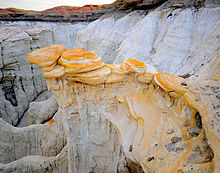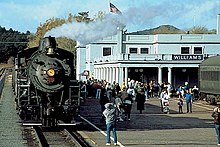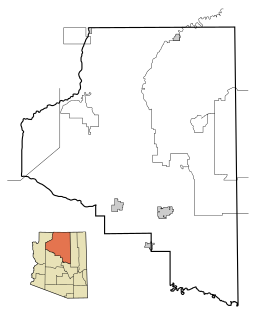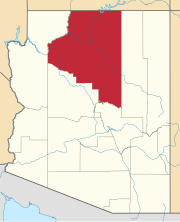Coconino County, Arizona
Coconino County | |
|---|---|
U.S. county | |
 Old Coconino County Courthouse in Flagstaff | |
 Logo | |
 Location within the U.S. state of Arizona | |
 Arizona's location within the U.S. | |
| Coordinates: 35°38′00″N 112°06′00″W / 35.633333333333°N 112.1°W | |
| Country | |
| State | |
| Founded | February 18, 1891 |
| Seat | Flagstaff |
| Largest city | Flagstaff |
| Area | |
| • Total | 18,661 sq mi (48,330 km2) |
| • Land | 18,619 sq mi (48,220 km2) |
| • Water | 43 sq mi (110 km2) 0.2%% |
| Population (2010) | |
| • Total | 134,421 |
| • Estimate (2019) | 143,476 |
| • Density | 7.2/sq mi (2.8/km2) |
| Time zone | UTC−7 (Mountain) |
| Congressional district | 1st |
| Website | coconino |




Coconino County is a county located in the north-central part of the U.S. state of Arizona. Its population was 134,421 at the 2010 census.[1] The county seat is Flagstaff.[2] The county takes its name from Cohonino,[3] a name applied to the Havasupai people. It is the second-largest county by area in the contiguous United States, behind San Bernardino County, California. It has 18,661 sq mi (48,300 km2), or 16.4% of Arizona's total area, and is larger than each of the nine smallest states in the U.S.
Coconino County comprises the Flagstaff metropolitan statistical area, Grand Canyon National Park, the federally recognized Havasupai Nation, and parts of the federally recognized Navajo, Hualapai, and Hopi nations. As a result, its relatively large Native American population makes up nearly 30% of the county's total population; it is mostly Navajo, with smaller numbers of other tribes.
The county was the setting for George Herriman's early 20th-century Krazy Kat comic strip.
History[]
After European Americans completed the Atlantic & Pacific Railroad in 1883, the region of northern Yavapai County began to undergo rapid growth. The people of the northern reaches had tired of the rigors of traveling to Prescott to conduct county business. They believed that they should have their own county jurisdiction, so petitioned in 1887 for secession from Yavapai and creation of a new Frisco County. This did not take place, but Coconino County was formed in 1891 and its seat was designated as Flagstaff.
Geography[]
According to the U.S. Census Bureau, the county has a total area of 18,661 square miles (48,330 km2), of which 18,619 square miles (48,220 km2) are land and 43 square miles (110 km2) (0.2%) are covered by water.[4] It is the largest county by area in Arizona and the second-largest county in the United States (excluding boroughs in Alaska) after San Bernardino County in California. It has more land area than each of the following states: Connecticut, Delaware, Hawaii, Maryland, Massachusetts, New Hampshire, New Jersey, Rhode Island, and Vermont.
The highest natural point in the county, as well as the entire state, is Humphreys Peak at 12,637 ft or 3,852 m. The Barringer Meteor Crater is located in Coconino County.
Adjacent counties[]
- Mohave County – west
- Yavapai County – south
- Gila County – south
- Navajo County – east
- San Juan County, Utah – northeast
- Kane County, Utah – north
Indian reservations[]
Coconino County has 7,142 sq mi (18,497.7 km2) of federally designated Indian reservations, second in scale only to Apache County. In descending order of area within the county, the reservations are the Navajo, Hualapai, Hopi, Havasupai, and Kaibab. The Havasupai Reservation is the only one that lies entirely within the county's borders.
National protected areas[]
- Apache-Sitgreaves National Forest (part)
- Coconino National Forest (part)
- Glen Canyon National Recreation Area (part)
- Grand Canyon National Park (part)
- Kaibab National Forest (part)
- Prescott National Forest (part)
- Sunset Crater Volcano National Monument
- Vermilion Cliffs National Monument
- Walnut Canyon National Monument
- Wupatki National Monument

Demographics[]
| Historical population | |||
|---|---|---|---|
| Census | Pop. | %± | |
| 1900 | 5,514 | — | |
| 1910 | 8,130 | 47.4% | |
| 1920 | 9,982 | 22.8% | |
| 1930 | 14,064 | 40.9% | |
| 1940 | 18,770 | 33.5% | |
| 1950 | 23,910 | 27.4% | |
| 1960 | 41,857 | 75.1% | |
| 1970 | 48,326 | 15.5% | |
| 1980 | 75,008 | 55.2% | |
| 1990 | 96,591 | 28.8% | |
| 2000 | 116,320 | 20.4% | |
| 2010 | 134,421 | 15.6% | |
| 2019 (est.) | 143,476 | [5] | 6.7% |
| U.S. Decennial Census[6] 1790–1960[7] 1900–1990[8] 1990–2000[9] 2010–2018[1] | |||
2000 census[]
As of the 2000 census, 116,320 people, 40,448 households, and 26,938 families were living in the county. The population density was 6 people per square mile (2/km2). The 53,443 housing units averaged 3 per sq mi (1/km2). The racial makeup of the county was 63.1% White, 28.5% Native American, 1.0% African American, 0.8% Asian, 4.2% from other races, and 2.4% from two or more races. About 10.9% of the population were Hispanics or Latinos of any race. Around 18.6% reported speaking Navajo at home, while 6.6% spoke Spanish.[10]
Of the 40,448 households, 34.9% had children under the age of 18 living with them, 49.7% were married couples living together, 12.2% had a female householder with no husband present, and 33.4% were not families. About 22.1% of all households were made up of individuals, and 4.5% had someone living alone who was 65 years of age or older. The average household size was 2.80, and the average family size was 3.36.
In the county, the age distribution was 28.7% under 18, 14.4% from 18 to 24, 29.2% from 25 to 44, 20.7% from 45 to 64, and 7.0% who were 65 or older. The median age was 30 years. For every 100 females, there were 99.70 males. For every 100 females age 18 and over, there were 97.20 males.
The median income for a household in the county was $38,256, and for a family was $45,873. Males had a median income of $32,226 versus $25,055 for females. The per capita income for the county was $17,139. About 13.1% of families and 18.2% of the population were below the poverty line, including 22.3% of those under age 18 and 13.3% of those age 65 or over.
2010 census[]
As of the 2010 census, 134,421 people, 46,711 households, and 29,656 families were living in the county.[11] The population density was 7.2 inhabitants per square mile (2.8/km2). The 63,321 housing units had an average density of 3.4 per square mile (1.3/km2).[12] The racial makeup of the county was 61.7% White (55.2% non-Hispanic White), 27.3% American Indian, 1.4% Asian, 1.2% African American, 0.1% Pacific Islander, 5.2% from other races, and 3.1% from two or more races. Those of Hispanic or Latino origin made up 13.5% of the population.[11] The largest ancestry groups were:[13]
Of the 46,711 households, 33.1% had children under the age of 18 living with them, 45.0% were married couples living together, 12.7% had a female householder with no husband present, 36.5% were not families, and 24.5% of all households were made up of individuals. The average household size was 2.69, and the average family size was 3.26. The median age was 31.0 years.[11]
The median income for a household in the county was $49,510 and for a family was $58,841. Males had a median income of $42,331 versus $31,869 for females. The per capita income for the county was $22,632. About 11.6% of families and 18.6% of the population were below the poverty line, including 22.5% of those under age 18 and 13.8% of those age 65 or over.[14]
Communities[]

Cities[]
Towns[]
Census-designated places[]

- Bellemont
- Bitter Springs
- Blue Ridge
- Cameron
- Doney Park
- Forest Lakes
- Fort Valley
- Grand Canyon Village
- Greenehaven
- Kachina Village
- Kaibab Estates West
- Kaibito
- LeChee
- Leupp
- Moenkopi
- Mormon Lake
- Mountain View Ranches
- Mountainaire
- Munds Park
- Oak Creek Canyon
- Parks
- Red Lake
- Supai
- Tolani Lake
- Tonalea
- Tuba City
- Valle
- Winslow West (mostly in Navajo County)
Other communities[]
Ghost towns[]
Indian reservations[]
- Havasupai Indian Reservation
- Hopi Reservation
- Hualapai Indian reservation
- Kaibab Indian Reservation
- Navajo Nation
County population ranking[]
The population ranking of the following table is based on the 2010 census of Coconino County.[15][16] † county seat
| Rank | City/town/etc. | Population (2010 Census) | Municipal type | Incorporated |
|---|---|---|---|---|
| 1 | † Flagstaff | 65,870 | City | 1928 |
| 2 | Sedona (mostly in Yavapai County) | 10,031 | City | 1988 |
| 3 | Tuba City | 8,611 | CDP | |
| 4 | Page | 7,247 | City | 1975 |
| 5 | Doney Park | 5,395 | CDP | |
| 6 | Williams | 3,023 | City | 1901 |
| 7 | Kachina Village | 2,622 | CDP | |
| 8 | Grand Canyon Village | 2,004 | CDP | |
| 9 | Kaibito | 1,522 | CDP | |
| 10 | LeChee | 1,443 | CDP | |
| 11 | Fredonia | 1,314 | Town | 1956 |
| 12 | Parks | 1,188 | CDP | |
| 13 | Mountainaire | 1,119 | CDP | |
| 14 | Moenkopi | 964 | CDP | |
| 15 | Leupp | 951 | CDP | |
| 16 | Cameron | 885 | CDP | |
| 17 | Valle | 832 | CDP | |
| 18 | Fort Valley | 779 | CDP | |
| 19 | Munds Park | 631 | CDP | |
| 20 | Tusayan | 558 | Town | 2010 |
| 21 | Tonalea | 549 | CDP | |
| 22 | Bitter Springs | 452 | CDP | |
| 23 | Winslow West (mostly in Navajo County) | 438 | CDP | |
| 24 | Tolani Lake | 280 | CDP | |
| 25 | Supai | 208 | CDP | |
| 26 | Kaibab (mostly in Mohave County) | 124 | CDP |
Politics[]
Coconino County has trended towards the Democratic Party in modern times after being a Republican stronghold between the 1950s and 1980s. It was won by every Republican presidential nominee between 1952 and 1988; however, no Republican since George H. W. Bush in 1988 has managed to come within 6% of reclaiming the county.
Economy[]
Grand Canyon Airlines and Air Grand Canyon are headquartered on the grounds of Grand Canyon National Park Airport in Tusayan.[19][20]
In 2017, the largest employers in Coconino County were:[21]
| # | Employer | # of employees |
|---|---|---|
| 1 | Northern Arizona University | 3,500 |
| 2 | W.L. Gore & Associates | 3,060 |
| 3 | Flagstaff Medical Center | 2,180 |
| 4 | Flagstaff Unified School District | 1,590 |
| 5 | Aramark | 1,310 |
| 6 | Coconino County | 1,080 |
| 7 | City of Flagstaff | 750 |
| 8 | National Park Service | 700 |
| 9 | Page Unified School District 8 | 680 |
| 10 | State of Arizona | 670 |
| 11 | Grand Canyon Railway | 600 |
| 12 | 510 | |
| 13 | Salt River Project | 500 |
| 14 | United States Forest Service | 490 |
| 15 | Walmart | 470 |
According to the Bureau of Economic Analysis, in 2019 the employment of Coconino County in the following sectors was:[22]
| Sector | Number of jobs | Percent | National percent |
|---|---|---|---|
| Accommodation and food services | 14,472 | 16.6% | 7.5% |
| Health care and social assistance | 9,901 | 11.4% | 11.3% |
| Retail trade | 8,201 | 9.4% | 9.4% |
| State government | 8,078 | 9.3% | 2.7% |
| Local government | 7,780 | 8.9% | 7.1% |
| Manufacturing | 4,202 | 4.8% | 6.7% |
| Real estate and rental and leasing | 4,072 | 4.7% | 4.8% |
| Other services (except government) | 3,883 | 4.5% | 5.8% |
| Professional, scientific, and technical services | 3,777 | 4.3% | 7.2% |
| Construction | 3,766 | 4.3% | 5.5% |
| Arts, entertainment, and recreation | 3,507 | 4.0% | 2.4% |
| Federal civilian | 2,687 | 3.1% | 1.4% |
| Administrative and support and waste management and remediation services | 2,592 | 3.0% | 6.2% |
| Transportation and warehousing | 2,162 | 2.5% | 4.5% |
| Farming | 2,110 | 2.4% | 1.3% |
| Finance and insurance | 1,813 | 2.1% | 5.4% |
| Wholesale trade | 1,235 | 1.4% | 3.2% |
| Educational services | 1,109 | 1.3% | 2.4% |
| Information | 715 | 0.8% | 1.7% |
| Military | 291 | 0.3% | 1.0% |
| Forestry, fishing, and related activities | 230 | 0.3% | 0.5% |
| Management of companies and enterprises | 216 | 0.2% | 1.4% |
| Utilities | 185 | 0.2% | 0.3% |
| Mining, quarrying, and oil and gas extraction | 175 | 0.2% | 0.6% |
| Total | 87,159 | 100.0% | 100.0% |
Transportation[]
Flagstaff in Coconino County is a major highway junction, with Interstate 40 extending to the east and the west (connecting with Williams and Winslow, Arizona, for example), and with Interstate 17 extending south from Flagstaff to Phoenix and Maricopa County. U.S. Routes 89 and 180 extend north from Flagstaff and connect it with the Grand Canyon National Park.
The Grand Canyon National Park Airport is a public airport located in Tusayan,[19] near the South Rim of the Grand Canyon.
Flagstaff Pulliam Airport is a public airport located four miles (6 km) south of the central business district of Flagstaff, it is mostly used for general aviation but is also served by two commercial airlines.
There is a Greyhound Bus Lines station in Flagstaff, with regular service east–west along Interstate 40, and also north–south service to Phoenix along Interstate 17.
Amtrak has a passenger railroad stations in Flagstaff and formerly in Williams, with daily service on the Southwest Chief to the east towards Chicago, and to the west towards Los Angeles.
The Grand Canyon Railway, a tourist railroad, links Williams with the canyon's South Rim in the Grand Canyon National Park and has service every day except Christmas.
The Mountain Line provides public transportation bus service in the Flagstaff area.
Major highways[]
 I-17
I-17 I-40
I-40 I-40 BL
I-40 BL US 66
US 66 US 89
US 89 US 89A
US 89A US 160
US 160 US 180
US 180 State Route 64
State Route 64 State Route 87
State Route 87 State Route 89
State Route 89 State Route 89A
State Route 89A State Route 98
State Route 98 State Route 99
State Route 99 State Route 260
State Route 260 State Route 264
State Route 264
See also[]
- National Register of Historic Places listings in Coconino County, Arizona
- USS Coconino County (LST-603)
References[]
- ^ Jump up to: a b "State & County QuickFacts". United States Census Bureau. Archived from the original on November 26, 2015. Retrieved May 18, 2014.
- ^ "Find a County". National Association of Counties. Archived from the original on May 31, 2011. Retrieved June 7, 2011.
- ^ "History of Coconino".
- ^ "2010 Census Gazetteer Files". United States Census Bureau. August 23, 2012. Retrieved August 23, 2015.
- ^ "Population and Housing Unit Estimates". Retrieved May 10, 2019.
- ^ "U.S. Decennial Census". United States Census Bureau. Retrieved May 18, 2014.
- ^ "Historical Census Browser". University of Virginia Library. Retrieved May 18, 2014.
- ^ "Population of Counties by Decennial Census: 1900 to 1990". United States Census Bureau. Retrieved May 18, 2014.
- ^ "Census 2000 PHC-T-4. Ranking Tables for Counties: 1990 and 2000" (PDF). United States Census Bureau. Retrieved May 18, 2014.
- ^ "Language Map Data Center".
- ^ Jump up to: a b c "DP-1 Profile of General Population and Housing Characteristics: 2010 Demographic Profile Data". United States Census Bureau. Archived from the original on February 13, 2020. Retrieved January 20, 2016.
- ^ "Population, Housing Units, Area, and Density: 2010 – County". United States Census Bureau. Archived from the original on February 13, 2020. Retrieved January 20, 2016.
- ^ "DP02 Selected Social Characteristics in the United States – 2006–2010 American Community Survey 5-Year Estimates". United States Census Bureau. Archived from the original on February 13, 2020. Retrieved January 20, 2016.
- ^ "DP03 Selected Economic Characteristics – 2006–2010 American Community Survey 5-Year Estimates". United States Census Bureau. Archived from the original on February 13, 2020. Retrieved January 20, 2016.
- ^ Promotions, Center for New Media and. "US Census Bureau 2010 Census".
- ^ Geography, US Census Bureau. "2010 Census Block Maps".
- ^ "Dave Leip's Atlas of United States Presidential Elections". Retrieved June 11, 2011.
- ^ Scammon, Richard M. (compiler); America at the Polls: A Handbook of Presidential Election Statistics 1920–1964; pp. 42–44 ISBN 0405077114
- ^ Jump up to: a b "Our Location Archived July 11, 2011, at the Wayback Machine." Grand Canyon Airlines. Retrieved on October 3, 2009.
- ^ "Locate Us Archived March 23, 2009, at the Wayback Machine." Air Grand Canyon. Retrieved on October 3, 2009.
- ^ Coconino County – Business, Jobs, and Industry Highlights
- ^ [1]
External links[]
| Wikimedia Commons has media related to Coconino County, Arizona. |
 Geographic data related to Coconino County, Arizona at OpenStreetMap
Geographic data related to Coconino County, Arizona at OpenStreetMap- Official website
- Coconino County profile Archived March 14, 2009, at the Wayback Machine at Arizona Department of Commerce
- Geologic Map of the Eastern Quarter of the Flagstaff 30ʹ x 60ʹ Quadrangle, Coconino County, Northern Arizona United States Geological Survey
- Arizona counties
- Coconino County, Arizona
- 1891 establishments in Arizona Territory
- Populated places established in 1891


